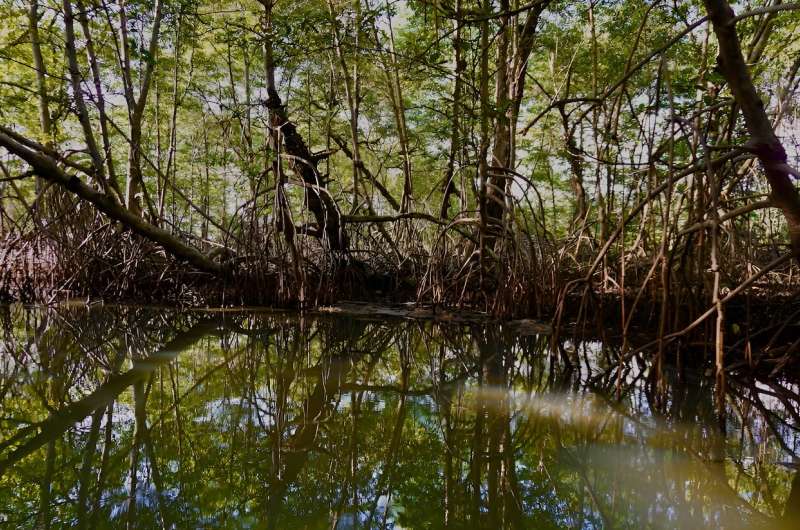January 11, 2024 report
This article has been reviewed according to Science X's editorial process and policies. Editors have highlighted the following attributes while ensuring the content's credibility:
fact-checked
peer-reviewed publication
trusted source
proofread
A 22-million-year-old petrified mangrove forest found in the Panama Canal

A team of environmental and natural scientists from Universidad EAFIT in Colombia, the Smithsonian Tropical Research Institute in Panama, and Boise State University in the U.S. has found evidence of an ancient petrified mangrove forest on an island in the Panama Canal. For their study, reported in the journal Palaeogeography, Palaeoclimatology, Palaeoecology, the group collected fossils and sediment samples from the island.
Prior research has shown that approximately 23 million years ago, the South American and Caribbean plates collided, pushing up parts of what is now Central America. One region became a large hill, forming what is now known as Barro Colorado Island—it is situated in Gatun Lake, which is part of the Panama Canal.
In this new effort, the research team studied 121 pieces of preserved wood found on the island over the past several years. They also studied sediment samples collected from the sites where the fossils were found. They determined that many of the fossils had come from a type of mangrove tree that no longer exists.
Dating of the fossils showed them to be approximately 22 million years old. Also, the sediment was from a lahar—a type of mud-and-rock river, similar in many ways to concrete, which forms as water flows down a mountain after a volcanic eruption.
The researchers suggest that approximately 1 million years after the formation of Barro Colorado Island, a volcano erupted, followed by a lahar, which covered the island with mud and rocks. It also covered the mangrove forest that had grown around the edges of the island. And because the lahar would have had silica-rich water, which aids in petrification, and due to the high speed at which the trees were covered, the perimeter of the island became a petrified forest, most of which is still buried.
The research team has named the new tree species Sonneratioxylon barrocoloradoensis. They suspect that due to higher levels of carbon dioxide in the air at the time of its existence, it likely grew taller than modern mango trees.
More information: Camila Martínez et al, An early Miocene (Aquitanian) mangrove fossil forest buried by a volcanic lahar at Barro Colorado Island, Panama, Palaeogeography, Palaeoclimatology, Palaeoecology (2023). DOI: 10.1016/j.palaeo.2023.112006
Journal information: Palaeogeography, Palaeoclimatology, Palaeoecology
© 2024 Science X Network





















